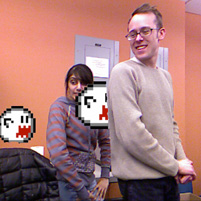Game Changers

Teaching is an art. And inspiration can come from anywhere, if you're open to it.
Just take a peek inside Golan Levin's Interactive Art and Computational Design class at Carnegie Mellon University.
Inspired by the artistic projects and research investigations of hackers and coders around the world, the art professor challenged his students to create a new interactive experience using the Xbox's Kinect sensor.
Why the Kinect?
"It's a game-changing device that radically simplifies some of the most challenging issues in computer vision," he said.
"With the Kinect sensor, the power to develop new forms of interaction is within the reach of a much wider group of novices, students and other developers."
John Horstman (CS'11), working towards a master's degree in human-computer interaction, agrees the possibilities were vast.
His team chose a project concept similar to Boo's behavior in the Super Mario Brothers game.
Horstman says the project deadline forced his team to be selective in choosing which features to implement.
"After we established a core idea, we brainstormed several features to enhance the interaction, such as the evil laugh and the gentle ghostly floating."
Nisha Kurani (CS'11) learned what the group was capable of, given a relatively short time frame.
"Golan's class is composed of students from various fields of study — art, design, human-computer interaction, architecture, and computer science — and it's a real melting pot for creative ideas," Kurani said.
"So many great projects came out of that assignment, and it was a huge motivator to see what our colleagues were creating as we developed our own idea."
The students had about two weeks to create the projects from start to finish. To create their projects, they used Processing, OpenFrameworks and Cinder, which are popular open-source, cross-platform toolkits for arts-computing.
"These are libraries made for artists, by artists, to allow for rapid development of high-quality multimedia applications in C++ and Java languages," Levin explained.
He added, "I chose to assign this project because of the high degree of cultural currency and the low barrier to entry."
"The playing field is wide open, and even students with relatively novice programming skills have the opportunity to make a significant contribution, and become widely known for it."
Indeed they have. Students completed 16 projects that can be viewed online.
To date, the projects have been viewed over 60,000 times — and featured widely in the media.
Related Links: Read the PC World Article | About the Course | School of Art
